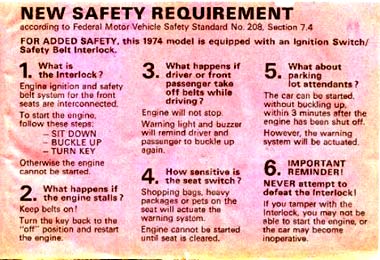Incorrect.
The starter disable system was already installed at the factory on all modern (1993-newer) cars to prevent them from starting unless the clutch pedal is depressed (on manuals) or the transmission in is park and brake pedal depressed (on automatics.)Additionally, on some of the cars these systems can also disable the starter if the oil pressure is too low or the coolant temperature is too high. There would be no conceivable safety or liability issues involved with simply adding unbuckled seat belt or open doors to the conditions that will prevent the car from starting.
The only real drawback that I can see to such a system.... from a management standpoint at least.... would be 100% compliance and the resulting lack of reports to shuffle, collate, document, duplicate and bloviate upon.
I agree that the only way to ensure 100% compliance with any process or program is to make it fool-proof, meaning it won't work if its not done the way intended.
My point is that the company has very little exposure now for seat belt mis-use, so there is little financial reason to spend a lot of money to make it fool-proof. You'd have a hard time suing the company for negligence if you are the one that is negligent by not putting on your own seat belt, especially when they can clearly demonstrate that they go well above the norm to enforce wearing it.
Who would be named in a lawsuit involving a death caused by the seat belt activated starter/ignition disable if the system was installed by the company without authorization from the vehicle manufacturer? Can you can say UPS definitely would not be sued? If not, there is potential liability.
There is no black and white when it comes to liability. Anyone can be sued for anything. All it takes is one jury to rule in favor of the claimant. There is no definite way to establish zero liability. The best that can be done is to avoid taking steps that
may be considered negligent.
Unfortunately we live in a world where people sue for everything from spilling hot coffee in their lap to using an electric hair dryer in the bathtub...and win!
PS - no bloviating allowed on the far right.


